Chapter 12 assembled 20jy02
previous
contents index
next
CHAPTER 12 Meat, Poultry, and Game
301 Food Value.
Meat, game, and poultry are first-class body-building foods and,
in addition, contain some of the protective foods for keeping the
body in good health. Liver, kidney, and heart are particularly rich
in iron, which keeps the blood healthy and helps the body to resist
colds and other ailments. Liver is also one of the richest known
sources of Vitamin A, and kidney contains a fair amount too. This
vitamin is needed to keep the eyes and the linings of the breathing,
digestive, and reproductive systems healthy, and for general growth.
Meat contains some of the B vitamins, but here again liver and kidney
are the best value.
Because meat can also be a source of harmful bacteria, it should
always be eaten cooked, as cooking destroys bacteria. This is
particularly important with such meats as sausages, mince-meat, and
pork.
302 General Information.
Lean meat is made up of bundles of fibres or long cells which
contain protein, water, salts, and extractives. Extractives are the
substances which give meat its particular flavour, and the meat from
old animals contains more than that from the young. Therefore beef
has more flavour than veal.
These bundles of fibres are held together by a substance called
connective tissue. Muscles which have a great deal of use, such as
leg-muscles, have more connective tissue than others, and it can be
easily seen as
141 MEAT, POULTRY,-AND GAME
gristle. The less connective tissue meat has, the more tender it
is. Heat and moisture soften connective tissue, allowing the
muscle-fibres to fall apart, and thus the meat becomes tender. Cuts
of meat containing a lot of gristle must always be cooked by one of
the moist methods, such as stewing or braising, so that they will be
sure to be tender. Only the cuts of meat which do not contain much
connective tissue are suitable for 'dry' methods of cooking, such as
roasting, grilling, and frying.
The alternative method of making tough meat tender is by mincing,
which breaks up the connective tissue, and the same idea lies behind
the custom of beating steaks before cooking.
Acids help to soften connective tissue. There is an acid present
in meat muscle called lactic acid, and during the process of
'hanging' meat after killing, this acid gradually produces softening.
If vinegar, lemon-juice, wine, cider, or beer are added during or
before cooking they have much the same effect.
Another effect of cooking is to make the meat shrink and, in
shrinking, it squeezes out juice. With the juice go some of the
extractives or flavour and some of the salts, and water. These are
not lost, as they help to form the gravy. With dry methods of
cooking, such as roasting and grilling, some of the extractives and
salts stay on the outside of the meat to form a crust, which gives
the particularly attractive flavour to meat cooked by this method.
303 Quantities of Meat to Buy.
- Meat without bone, 4-6 oz.
[110-170g] per person
Feet, calf's and pig's, 1 per
person
Meat with bone, 6-8 oz.
[170-225g] per person
Head, sheep's, serves 2-3
Head, calf's, serves 10 or more
Brains, 1 small per person
Head, pig's, serves 7-8
142 THE PENGUIN COOKERY BOOK
Ears, pig's, 2 per person
Kidney, sheep's and pig's, I per
person
Kidney, calf's, serves 2
Liver, 4-6 oz. [110-170g] per
person
Ox-tail serves 3-4
Sausages, 4 oz. [110g] per
person
Sweetbreads, 1 per person
Tongue, sheep's, 1 per person
Tongue, ox, serves 6 or more
Tripe, 4 oz. [110g] per person
Blackcock and Widgeon serves 3-4
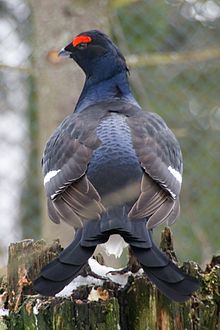
Chicken serves 4-6
Heart, calf's, serves 4-5
Heart, sheep's, serves 1
Duck serves 8-9
Duckling serves 4-5
Goose serves 10 or more
Grouse serves 3
Guinea-fowl serves 4-5
Hare serves 5-6
Partridge serves 2-3
Pheasant serves 2-4
Pigeon serves 2-3
Plover serves 2
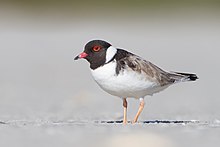
Quail and Ortolan, allow 1 each
Rabbit serves 4-5
Teal, Ptarmigan, Snipe, and
Woodcock serves 1-2
Turkey serves 10 or more
304 Carving.
Good carving is not difficult if you have a really sharp
carving-knife. The important thing to remember is that meat must
always be carved ACROSS the grain, and not with it. One cut with the
knife should be sufficient to show if it is going in the right
direction. If you are cutting the wrong way, that is, with the grain
- you will clearly see the long fibres of meat, instead of the fine
surface produced by cutting across the fibres. A little experience
will soon tell you which way to start tackling any joint.
Beef is nicer if cut in very thin slices, but lamb and pork are
generally cut a little thicker.
When carving game and poultry, begin by cutting off the legs at
the joint closest to the body. The breast is then cut in slices
upwards.
23de00
pp 143-220
cook19
MEAT, POULTRY, AND GAME 143
With a calf's or pig's head the cheek is the meaty part, and
should be carved from mouth to ear.
CHOOSING MEAT
305 General Information.
The ideal is to be able to make up your mind in advance exactly
what cut you want to buy and how you are going to cook and serve it,
but in practice it seldom works out like that. If you are new to
shopping, the best thing to do is to ask the butcher's advice. Either
ask him the name of the cut you are buying and then look in your
cookery book for the best way of treating it, or else ask him quick
whether it is suitable for roasting or stewing. If he says it will
roast, 'but cook it slowly', you will be well advised to treat it
like a tough cut, and braise or pot roast it.
The ideal place to keep meat, poultry, and game is in a
refrigerator; otherwise in a cold larder or a safe hung in a cool,
airy place. It must always be protected from flies, and special
covers can be bought for this purpose.
Raw meat, poultry, and game do not need covering in a
refrigerator, but when cooked they should be covered to prevent them
from becoming dry. Bacon should be covered to prevent drying.
Suitable covers to use in the refrigerator are waxed paper,
cellophane, aluminium foil, and plastic.
306 Choosing Beef.
Good-quality beef is light red, fine in grain, firm, and elastic
to touch, and marbled with fine, cream-coloured fat. Poor quality
beef is flabby, dark, and coarse, with yellow fat.
If the meat contains any gristle it is not suitable for grilling,
frying, or ordinary roasting.
Cuts Suitable for Grilling and Frying: Rump, fillet, hip, or
pin-bone steak.
144 THE PENGUIN COOKERY BOOK
Suitable for Roasting: Round, top rump, top side, Sirloin, fore
ribs, wing ribs, standing ribs, best chine.
Suitable for Pot Roasting and Braising: Aitchbone, middle rump,
shell bone, middle ribs, back and top ribs, shoulder piece, chuck
ribs, brisket, plate.
Suitable for Stewing, Boiling, Pies, and Puddings: Leg, shin,
flank, bed piece, first cutting, brail, skirt, neck, clod, sticking
piece.
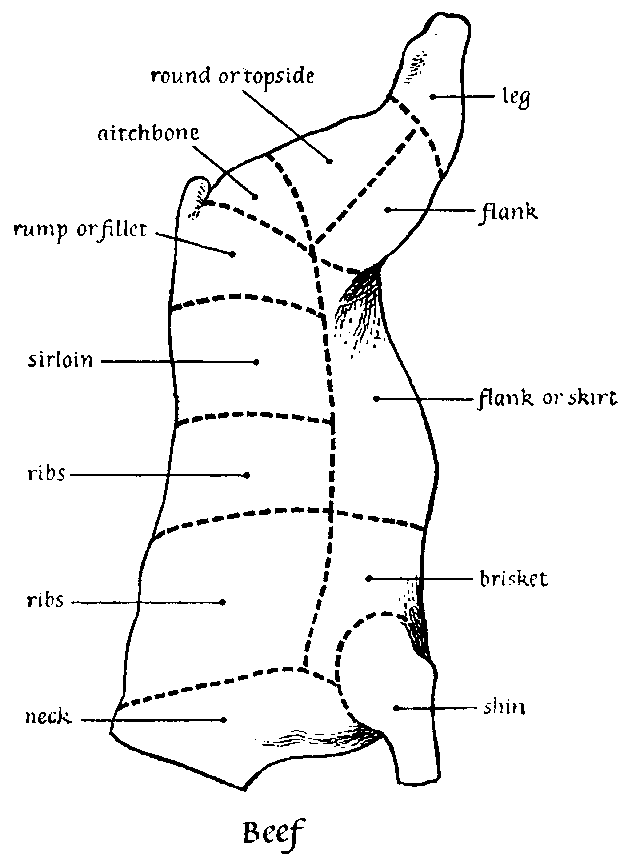
[g
p144]
Beef
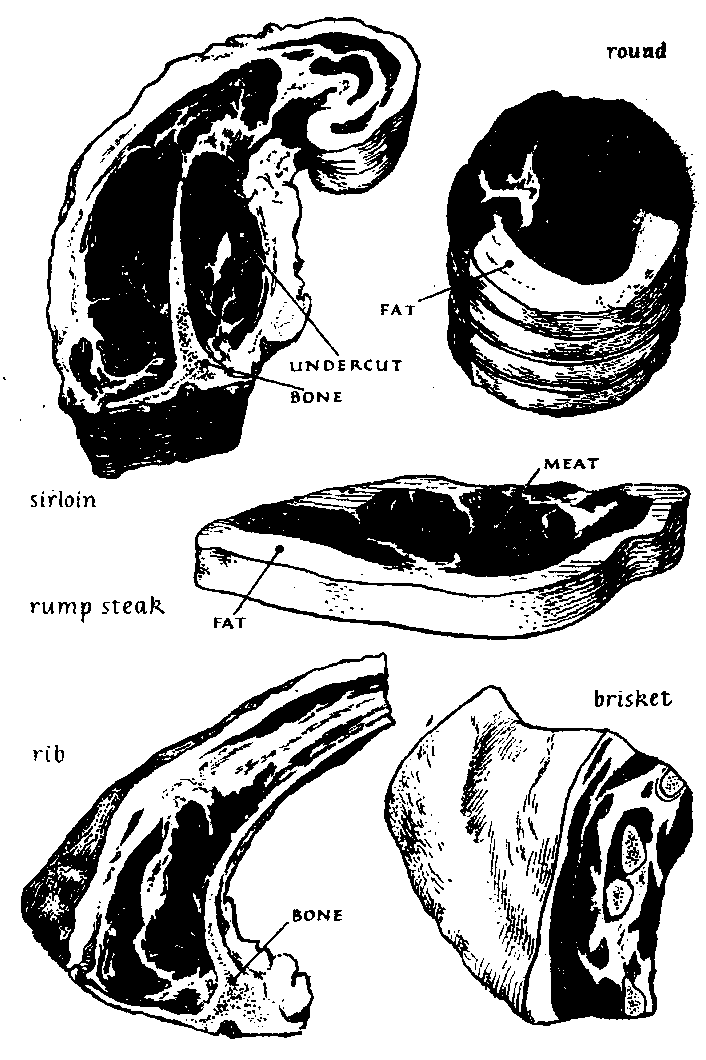
[g
p145 all]
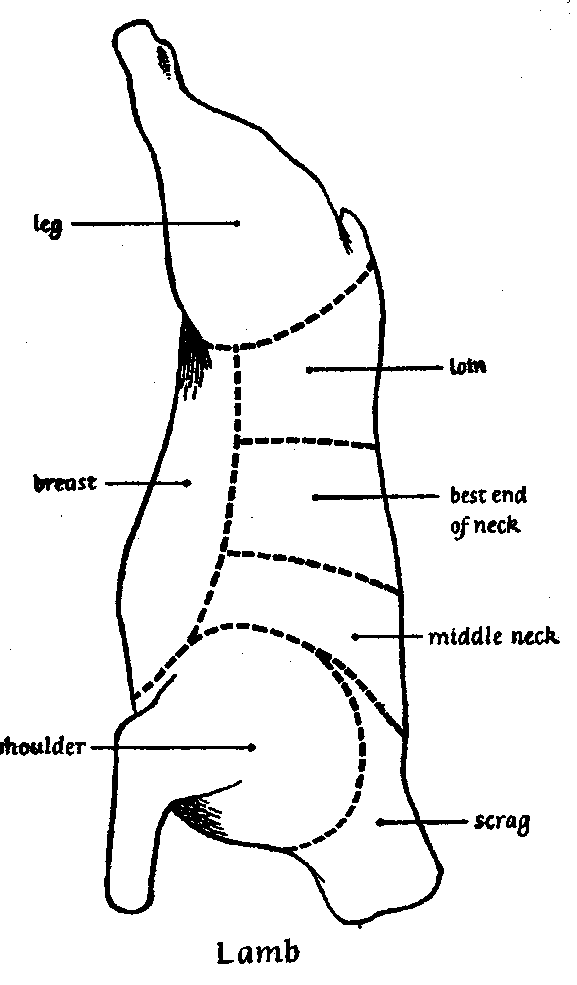
[g
p146 all]
cook20
MEAT, POULTRY, AND GAME 147
307 Choosing Lamb and Mutton.
Lamb should be red with white fat and the bones should be moist
and red at the joints.
Mutton should be bright red with yellowish fat and the bones
white.
Suitable for Grilling and Frying: Best end of neck, loin.
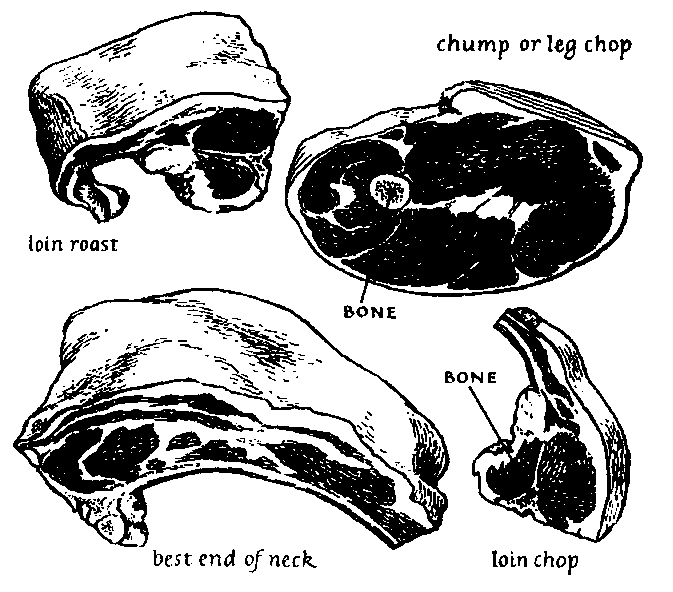
[g
p147]
Suitable for Roasting: Leg, loin, best end of neck, shoulder.
Suitable for Pot Roasting and Braising: Middle neck, scrag,
breast.
Suitable for Boiling and Stewing: Leg, neck, scrag, breast
(stuffed and rolled).
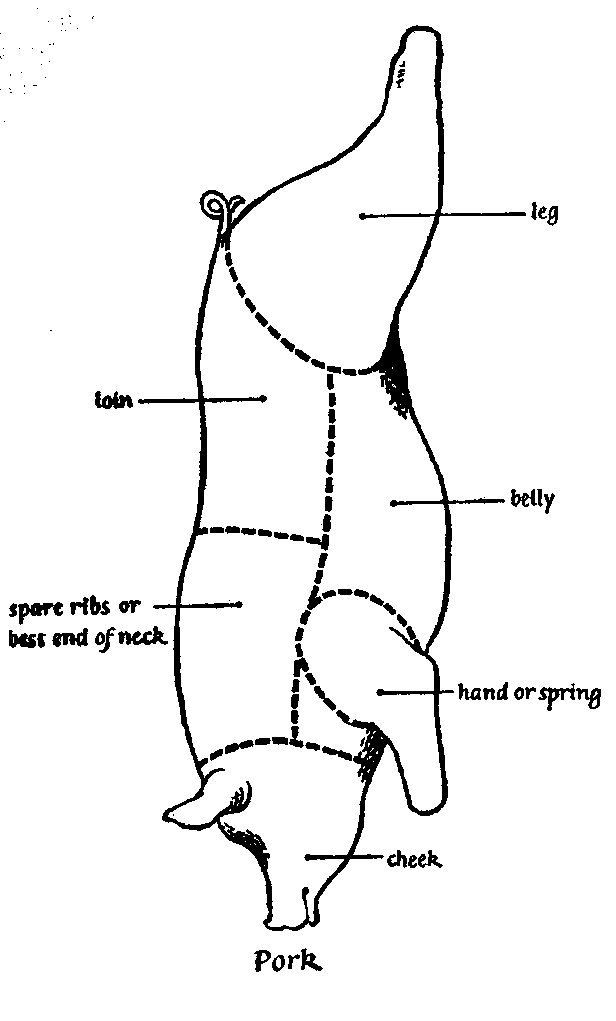
[g
p148 all]
MEAT, POULTRY, AND GAME 149
308 Choosing Pork.
Good-quality pork should be pale brownish-red with firm flesh and
white, firm fat.
Suitable for Grilling and Frying: Loin chops (thorough cooking
needed).
Suitable for Roasting: Leg, loin.
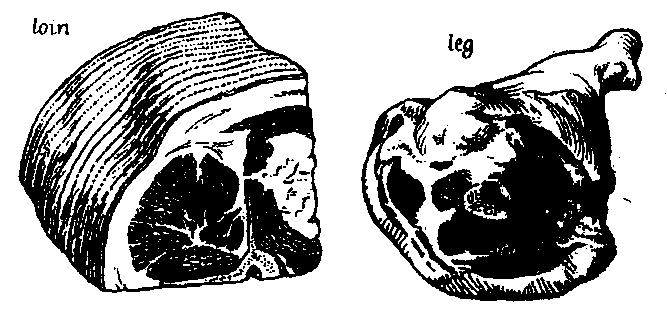
[g1
p149]
Suitable for Pot Roasting and Braising: Spare ribs, best end of
neck, blade bone, fine end.
Suitable for Boiling and Stewing: Leg, spare ribs, best end of
neck, blade bone, fine end, belly, hand and spring, head.
309 Choosing Veal.
Good-quality veal should be pale pink with clear, firm, white fat.
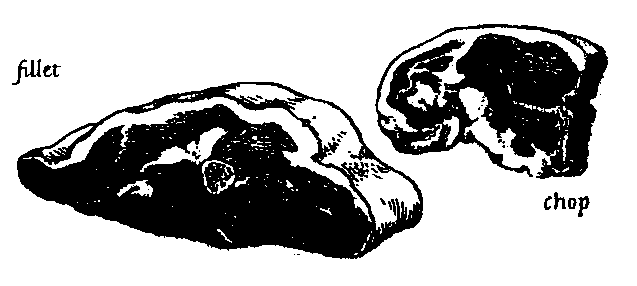
[g2
p149]
150 THE PENGUIN COOKERY BOOK
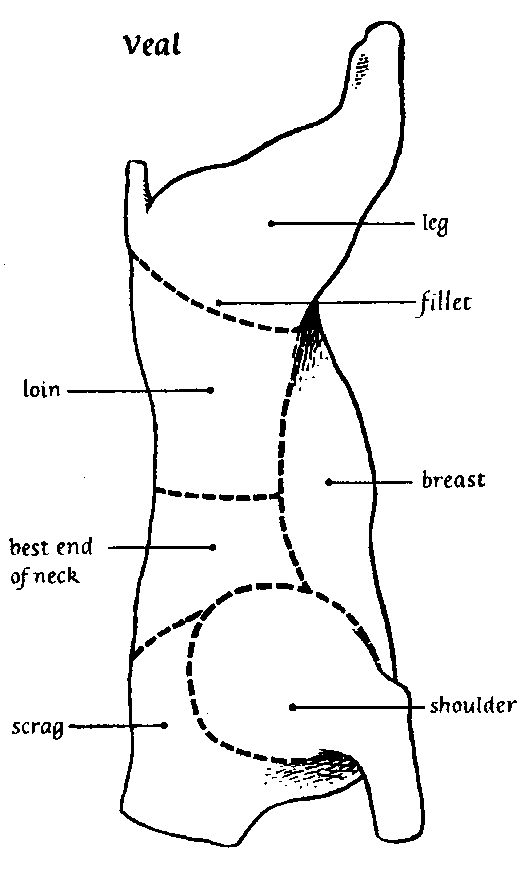
[g
p150]
Suitable for Grilling and Frying: Fillet, loin, best end of neck
(Thorough cooking needed.)
Suitable for Roasting: Leg, loin, shoulder.
Suitable for Pot Roasting and Braising: Best end of neck, breast
(rolled and stuffed).
Suitable for Boiling and Stewing: Breast, scrag, shoulder.
MEAT) POULTRY, AND GAME 151
310 Choosing Offal and Sundries.
BRAINS suitable for boiling, and may then be fried.
FEET suitable for stewing, braising, soups, brawn.
HEAD suitable for boiling, brawn, soups.
HEARTS suitable for stewing (cut up and mixed with other meat) and
braising (stuffed or plain).
KIDNEYS suitable for stews, puddings, pies, soups.
Lamb's kidneys suitable for frying and grilling.
LIVER (LAMB'S AND CALF'S) suitable for frying, stewing, braising.
OX LIVER suitable for stewing and braising.
OX - TAIL suitable for Soups, stews, braising.
SAUSAGES suitable for frying, grilling, stewing, loaves, and pies.
SWEET BREADS suitable for braising, frying, grilling.
TONGUES suitable for boiling, braising, brawn.
TRIPE suitable for stewing, boiling, braising.
311 Choosing Poultry and Game.
The characteristics of a young bird are a soft, flexible beak and
breast bone and smooth feet and legs. An old bird will have a hard,
rigid beak and breast bone and rough, scaly feet and legs.
CHICKENS are roasted or fried if very young.
FOWLS are stewed, braised, or boiled but may be steamed and then
roasted.
DUCKS OR DUCKLINGS are roasted or braised.
GEESE are roasted.
GUINEA-FOWL are roasted.
PIGEONS are stewed or grilled (if young).
TURKEYS are roasted.
Young hares and rabbits have smooth, sharp claws, ears that are
tender and easily torn, and a short, stumpy neck. Roasting is the
favourite method of cooking all game, but if it is old, stewing or
braising is advisable. Venison is
152 THE PENGUIN COOKERY BOOK
usually hung for 14 days, and then roasted. Neck chops may be
grilled as veal or pork chops. Venison may also be stewed.
PREPARING MEAT, POULTRY, AND GAME
FOR COOKING
312 Preparing Meat.
PRESH MEAT. Trim off surplus fat and keep it for rendering down
(see No.145). In warm weather, if the
meat has a slight smell wipe the surface with a cloth dipped in
vinegar.
SALT MEAT. If very salt, soak in cold water for 3-4 hours or
longer.
BRAINS. Soak in cold water until all the blood is removed. Remove
skin and fibres.
EARS (pig's). Soak in cold water for 5-6 hours.
FEET (cow's and calf's). Usually sold ready for cooking.
FEET (pig's and sheep's). Wash well.
HEAD (calf's). Ask the butcher to cut it in half lengthwise.
Remove the brains, and soak head and brains in cold water until all
the blood is removed. Change the water several times. Then blanch the
head by boiling 15 minutes. See No.13.
HEAD (pig's). If salted, soak in cold water.
HEAD (sheep's). Wash in several waters and then soak in salt water
for i hour. Then blanch by just bringing to the boil. See No.13.
HEART. Wash in several waters and leave to soak in cold water for
I hour. Squeeze out all blood.
KIDNEYS. Remove fat, skin, and hard core.
LIVER. Wash and dry.
OX-TAIL. Wash, dry, and cut in joints.
SWEETBREADS. Soak in cold water for I hour to remove the blood.
Blanch, as in No. 13, just bringing
lamb's sweetbreads to the boil but boiling calf's sweet-
MEAT, POULTRY) AND GAME 153
breads for 10-12 minutes. Leave to become cold. Remove all gristle
and tissue before completing the cooking.
TONGUE (ox). Soak in cold water for 2-3 hours; (sheep's and
pig's). Soak in cold water for 2 hours, and then blanch, see No.13
(calf's). Cooked with the head.
TRIPE. Usually sold ready for cooking.
313 Preparing Poultry.
I. Either pluck the bird directly after killing and while it is
still warm, or else put it in a bucket and pour boiling water over
it, when the feathers will be found to come out quite easily. Be
careful not to tear the skin. Remove the short pin-feathers with the
aid of a knife. Singe off the hairs by holding the bird over a
gas-flame, lighted taper, or spill of paper.
2. Cut off the head. Cut the neck-bone off close to the body, but
first pull back the skin, as you want this left long to fold over
neatly. The neck should be kept to cook with the other giblets for
stock. Remove the crop and wind-pipe from the neck end and loosen the
top of the entrails by working round the body with your forefinger.
3. Turn the bird on its back. Lift up the skin just above the vent
and make a long cut in it. Then cut round the vent. Loosen the fat
and then loosen the entrails by passing the right hand gently between
the inside walls of the body and the entrails. Hold the bird firmly
with the other hand while you do this. Then take hold of the gizzard,
which can easily be felt, as it is big and hard, and gently draw out
the entrails. Try not to damage the little gall-bladder attached to
the liver, as, if the gall gets on the liver, it makes it bitter and
unusable. You will be able to tell if this has happened, as there
will be a green patch on the liver. The lungs and kidneys do not
always come out with the entrails, so put in your hand again
154 THE PENGUIN COOKERY BOOK
and feel for them in the hollows by the backbone. Wash the inside
in cold running water and drain thoroughly.
4. Break the legs at the lower joint and bend them back. This
exposes the tendons. Lever up the exposed part with a skewer and pull
out the tendon, taking care not to tear the flesh.
5. Stuff from the neck end until the breast is plump. Draw the
skin back over the neck-opening and sew or skewer it firmly to seal
the opening. For sewing use a coarse needle and thick white cotton.
Stuff the body from the tail end. Push the tail through the slit and
skewer it there firmly.
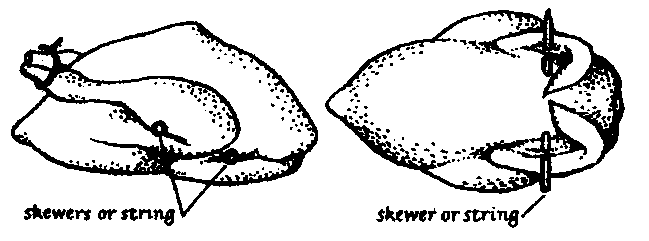
[g
p154]
6. To truss, draw the thighs close to the body and cross the legs
over the tail. Tie them together with string. Fold the wings
backwards and inwards over the neck skin and tie or skewer them.
7. The giblets consists of the neck, feet, heart, liver, and
gizzard. Clean them in the following way. Cut through the thick
muscle of the gizzard, lengthwise. Peel it off the rough, wrinkled
lining and discard the lining and contents. Cut the heart open
lengthwise. Remove the gall-bladder very carefully from the liver
and, if it should be broken, cut away any discoloured liver. Scald
the feet in boiling water for a minute or two and then peel off the
skin. Wash all the giblets and boil them in water with an onion, a
carrot, and seasonings for 1-2 hours, and use the liquid for gravy or
stock.
MEAT, POULTRY, AND GAME 155
314 Preparing Hares and Rabbits.
I. Cut off the legs at the first joints.
2. Slit the skin all along the belly and loosen it from the body.
Pull it off the hind legs. Then pull towards the head and off the
front legs.
3. Slit the belly and draw out the entrails. Keep the liver and
heart to use for making stock. Wash the animal well in cold water.
Truss for roasting by skewering or tying the legs close to the body;
or joint as follows.
Cut off the head. Cut out the eyes and split the head in half
lengthwise. Use it for stock.
Cut off the hind legs close to the body. The joints are quite easy
to find.
Cut the body in three or four pieces through the backbone. The
piece with the forelegs should be cut in half lengthwise.
BOILING
315 General Information.
Boiling is best suited to whole joints, breast of lamb or veal,
rabbits or fowls, tongues, salt meat, and similar foods. Smaller
pieces of meat lose so much flavour to the liquid that they are
better cooked by one of the other methods unless they are boiled with
the deliberate idea of flavouring the liquid for soup. This method is
used in many countries, the Scotch Broth being one example, the
French Pot au Feu another. The boiled meat is served as one course,
together with the vegetables cooked in the same liquid, and the stock
is used to make a soup.
You will find a list of suitable cuts of meat for boiling in Nos.
306-12.
N.B. Boiled meat may be cooked in a pressure cooker when ⅓-¼
the normal times will be required
156 THE PENGUIN COOKERY BOOK
316 Boiled Fresh Meat, Game, or Poultry.
I. It is advisable to choose a pan just big enough to hold the
meat, as the less liquid you have with it the better will be the
flavour of both meat and stock.
2. Boil the liquid and add a bouquet garni, and an onion stuck
with 3 or 4 cloves.
3. Add the meat and boil rapidly for 5 minutes. Skim well and
cover the pan.
4. Lower the heat and cook just below boiling (simmering) until
the meat is tender. A fine skewer will go in easily if the meat is
tender. For times see No.318.
5. If vegetables are being cooked with the meat they should be cut in large pieces and added ½-1 hour before the end of cooking, depending on the kind of vegetable. Add about I level Tbs. salt with the vegetables. Dumplings should be added ½ hour before serving.
6. Use the liquid for a sauce to serve with the meat and the
remainder as stock for soup.
317 Boiled Salt Meat (bacon, ham, pork, beef,
tongue, etc.).
This differs from fresh meat in that it is started in cold water in order to draw out the salt. If the meat is very salty it should be soaked in cold water for 3-4 hours or longer before cooking. If the meat is to be served cold it is better left to cool in the liquor, and if this is not too salt it may be used for stock.
318 Boiling Time Table.
Bacon and Ham: 25 minutes per lb. [450g] (1
lb. [450g] or under 45 minutes).
Beef, salt: 25-30 minutes per lb. [450g]
plus 25-30 minutes (1 lb. [450g] or
under 1 hour).
Beef, fresh: 20 minutes per lb. plus 20 minutes (1 lb. or under
¾-1 hour).
MEAT, POULTRY, AND GAME 157
Brains, calf's: 20 minutes or 10 minutes if to be fried
afterwards.
Brains, ox: 30 minutes.
Brains, sheep's and pig's: 15 minutes.
Ears, pig's: 1½ hours.
Feet, calf's and cow's: 2-3 hours.
Feet, pig's: 2 hours.
Fowl: 1-2½ hours depending on age and size.
Head, calf's: 3-4 hours.
Head, pig's (half): 1½-2 hours.
Head, sheep's: 1½-2 hours.
Mutton or Lamb: 15-20 minutes per lb. (breast, rolled 1-1½
hours).
Pork, salt: 25-30 minutes per lb.
Rabbit: 40-60 minutes.
Tongue, calf's: Cooked with the head or 2-3 hours.
Tongue, ox: 3-3½ hours.
Tongue, sheep's and pig's: 1½-2 hours.
Veal: 20-25 minutes per lb. (breast, rolled 1-1½ hours).
319 What to Serve with Boiled Meat, Poultry,
or Game.
BEEF. Boiled potatoes. Onions, carrots, swedes, turnips, cabbage
(cut in quarters), beetroot (cooked separately). Dumplings. Tomato
Sauce, No. 92; Parsley Sauce, No.89;
Horse-radish Sauce, No.82.
BOILED BACON OR SALT PORK. Boiled potatoes. Cabbage, carrots,
turnips, beetroot (cooked separately), beans. Pease Pudding, No.497;
Parsley Sauce, No.89; Tomato Sauce,
No.92.
BRAINS. After boiling, these are often sliced and fried. They
should be allowed to become cold, and then sliced and dipped in egg
and crumbs. If served boiled make a Parsley Sauce, No.89,
with some of the stock. Any vegetables may be served.
CALF'S FEET. The bones are removed after cooking,
158 PENGUIN COOKERY BOOK
the feet cut in pieces and served in a Parsley Sauce, No.
89, made from the cooking liquor, with some chopped cooked ham or
bacon in it. Serve with any vegetable.
CALF'S HEAD. Boiled potatoes. Vinaigrette Sauce, No.
117, with the cooked, mashed brains added. Slices of the tongue
are served with slices of the meat. A lettuce salad is generally
served afterwards.
FOWL. Boiled potatoes. Any green or root vegetables. Onion Sauce,
No. 87; Bread Sauce, No.
118; Egg Sauce, No.78; Parsley
Sauce, No. 89.
LAMB AND MUTTON. Boiled jacket potatoes. Swedes, carrots, turnips,
onions, and any green vegetables. Caper Sauce, No.73;
Parsley Sauce, No.89; Onion Sauce,
No.87; Fennel Sauce, No.79;
Red-currant jelly.
PIG'S EARS. These are generally cooked with the feet, then cut in
strips, and served with a Parsley Sauce, No.
89, made from the cooking liquor. Any vegetables are suitable.
RABBIT. Boiled jacket potatoes. Onions, carrots, turnips, and any
green vegetable. Dumplings. Boiled salt pork or bacon. Parsley Sauce,
No.89; Mint Sauce, No.
118.
SHEEP'S HEAD. The brains are added 15 minutes before the end of
cooking, and then mashed and added to a sauce made from some of the
cooking liquor. Root vegetables are cooked and served with the head.
Boiled potatoes are the best.
TONGUE. These are generally served cold with salad. After cooking
they are pressed in a basin or mould with a weight on top and left
until quite cold. If served hot, a Parsley Sauce, No.
89, or Tomato Sauce, No.92, is
suitable and any vegetables.
320 Boiled Breast of Lamb or Veal
Ask the butcher not to chop the breast in pieces. Remove the small
bones and any surplus fat. Place the meat
MEAT, POULTRY, AND GAME 159
skin side down and spread the inside with Veal Forcemeat, No.
142, or Mint Stuffing, No. 138.
Roll up tightly and tie with fine string. Boil as in No.
316.
Serve hot with a sauce made from the liquid, for example, Parsley
Sauce, No.89; Caper Sauce, No.73;
Brown Sauce, No. 72; Tomato Sauce, No.
92; Paprika Sauce, No.88; or (with lamb), Fennel Sauce, No.79.
Serve cold after pressing between two plates with a heavy weight
on top. Leave until cold, remove the string, and glaze. See No.
649. Cut in slices to serve.
321 Boiled Beef and Horse-radish Sauce.
Cooking time 2 hours.
Quantities for 8-10 helpings:
1½-2 pt. [855-1140ml] water
1 parsnip
2-2½ lb. [1135g] lean brisket beef
1 stalk of celery
½ Tbs. salt
1 onion
1 carrot
5 whole allspice
Measures level. Heat just enough water to cover the meat, and when it is boiling add the meat and other ingredients. Cook until tender. Serve the meat sliced and surrounded by the vegetables. Use the stock to make Horseradish Sauce, No. 82, or
use half stock and half milk. Serve with boiled potatoes and some
extra vegetables.
STEWS AND CASSEROLES
322 General Information.
Stews and casseroles are among the simplest and most useful of
meat dishes. They are economical because the cheapest cuts of meat
can be used, and, although the cooking time is long, very little fuel
is required; and yet they can be rich and savoury, and you need not
be ashamed to serve them at any meal. Stews and casseroles include
Ragouts, Curries, Hot Pots, Goulash, Jugged
160 THE PENGUIN COOKERY BOOK
Hare, and many other well-known dishes. They all depend for
success on the following three important points.
I. The use of very little liquid, so that the gravy is rich and
full of flavour.
2. Good flavouring. The use of vegetables, herbs, and spices to
combine with the meat for a savoury flavour.
3. Long, slow cooking. A stew should never be allowed to boil. It
should simmer, which is below boiling and just keeps the surface of
the liquid agitated, with an occasional bubble showing. Most stews
need at least 2 hours' cooking, preferably 3 hours or longer, as the
long cooking gives a rich flavour. This is most easily done in a
casserole in the oven, 315 F. [157°C] or Mark 2. You can arrange to cook
other dishes with it, and not waste oven space. Most casseroles are
sufficiently attractive to go to the table, so you save on the
washing-up too.
4. If you cook the stew in a saucepan on top of the stove you may
find the thickened liquid tends to catch, unless you have a thick pan
and a gentle heat. In that case it is better to thicken the liquid by
the Blending Method, No.93, after
cooking is finished.
Any of the recipes for stews are suitable for a pressure cooker,
allowing about 20 minutes or according to the instructions for
stewing given with the cooker. It is always better to thicken these
stews after cooking is finished, otherwise they will stick and burn.
323 Brown or White Stew (beef, lamb, veal,
pork, rabbit, chicken, etc.).
Cooking time 2 hours or longer.
Quantities for 4 helpings:
1 lb. [450g] meat without bone OR 1½ lb. [1350g] meat with bone
Pinch of thyme
2 oz. [55g] dripping (4 Tbs.)
4 Tbs. flour
cook21
MEAT, POULTRY, AND GAME 161
1 lb. [450g] mixed vegetables (e.g. 2 carrots, 1 onion, 1 turnip,
2 stalks celery)
¾ pt. [425ml] stock or water or use some beer or cider (1½ c.)
2 tsp. salt
I bay leaf
¼ tsp. pepper
Sprig of parsley
1 tsp. sugar
Measures level.
1. Cut the meat in pieces, removing as much fat as possible.
2. Prepare and slice or dice the vegetables.
3. For a White Stew melt the dripping in the saucepan and stir in
the flour, cooking until it turns yellow. Add the liquid and mix
well. Then add the rest of the ingredients and cook very slowly until
tender.
4. For a Brown Stew dip the meat in the flour and coat well. Fry
the meat brown in the fat, and then add the vegetables and fry for a
few minutes longer. Add any remaining flour, and then the liquid and
seasonings. Cook slowly until tender. Add gravy browning if necessary
for a good rich colour.
5. If dumplings are added they should go in half an hour before
serving, see No. 715.
6. Serve with boiled or mashed potatoes and a green vegetable.
N.B. A white stew is usually made with veal, lamb, chicken, or
rabbit, and a brown stew with beef, venison, hare, or chicken.
324 Casserole of Tripe. Cooking time 2-3
hours.
Quantities for 4 helpings:
1 lb. [450g] dressed tripe
½ tsp. mixed dried herbs
1 oz. [30g] lard or dripping (2 Tbs.)
¼ tsp. each of ground ginger, nutmeg, and cloves
2 Tbs. flour
¾ Pt. [425ml] stock (1½ c.)
Pinch of cayenne pepper
162 THE PENGUIN COOKERY BOOK
2 carrots
2 tsp. salt
2 turnips
1 tsp. chopped marjoram
2 sticks celery
2 Tbs. grated cheese
1 onion
Measures level. Cut the tripe in pieces about 2 inches square, and
cook as for White Stew, No. 323.
Serve with the marjoram and cheese sprinkled on top. Boiled potatoes
go with it.
325 Goulash (beef, veal, or lamb).
Cooking time 2-3 hours.
Quantities for 4 helpings:
2 onions, sliced
Pinch of caraway seeds
1 oz. [30g] dripping (2 Tbs.)
½ c. stock
1 lb. [450g] lean meat
1-1½ lb. potatoes (4-6 medium)
2 tsp. paprika pepper
1 tsp. salt
¼ c. tomato juice or 2 tomatoes
Measures level. Fry the onions and dripping in a saucepan. Cut the
meat in 1-2-inch cubes and add to the onions. Cook until brown, and
then add all the other ingredients except the potatoes. Cover and
cook very slowly for 2-3 hours. It may need a little more stock
during cooking. Boil the potatoes for 15-20 minutes and cut them in
quarters. Add them to the goulash for the last 10 minutes' cooking.
Mix carefully. Serve with boiled cabbage.
326 Curry. Cooking time 2-3 hours.
Quantities for 6-8 helpings:
2 lb. [900g] beef or mutton (no bone) or 1 rabbit
2 oz. [55g] dripping (4 Tbs.)
2 Tbs. curry powder
6 Tbs. flour
¾ Pt. [425ml] stock (1½ c.)
3 tsp. salt
Rind and juice of ½ lemon
2 medium sized onions
1 tsp. brown sugar
MEAT, POULTRY, AND GAME 163
1 clove garlic
1 Tbs. desiccated coconut
2 apples
1 tomato
2 Tbs. raisins or sultanas
Measures level. Cut the meat in pieces and roll in the flour and
salt mixed together. Chop the onions, garlic, apple, and tomato. Heat
the dripping in a saucepan and fry the vegetables and meat. Pour off
any excess fat. Add the curry powder and any flour left. Mix well and
stir in the stock. Add gravy browning if a dark curry is preferred.
Add the lemon juice, coconut, fruit, and sugar, and cook slowly for
2-3 hours. Serve with boiled rice and chutney. Follow with a salad.
327 Jugged Hare, Rabbit, Venison or Pigeons.
Cooking time 3-4 hours.
Temperature 300 F. [149°C] Mark 1.
Quantities for 6-8 helpings:
1 hare or 2 small rabbits OR 2-3 pigeons or 2 lb. venison (2 Tbs.)
1 tsp. grated lemon rind
1 oz. [30g] butter or margarine
1 oz. [30g] dripping (2 Tbs.)
4 Tbs. flour
2 onions, sliced
½ pt. [285ml] stock (1 c.)
Bouquet garni
¼ pt. [140ml] vinegar (4 c.)
6 cloves
¼ Pt. [140ml] red wine, cider, or beer (1 c.)
3 whole allspice
½ tsp. pepper
Forcemeat Balls, No. 142
2 tsp. salt
Measures level. Joint the meat and fry the pieces brown in the
dripping. Put in a casserole with the onion and seasonings. Melt the
butter or margarine and add the flour. Mix well and stir in the
liquid. Stir until it boils and pour over the hare. Cover and cook in
a slow oven for 3-4 hours.
164 THE PENGUIN COOKERY BOOK
Serve with fried forcemeat balls, boiled potatoes, red-currant
jelly, and any vegetable.
328 Les Carbonnades Flamandes (steak stewed
with beer). Cooking time 2-3 hours.
Quantities for 6-8 helpings:
2 lb. [900g] steak
¾ pt. [425ml] Beer (1½ c.)
8 Tbs. flour .
25 clove garlic, chopped
3 tsp. salt
Bouquet garni
¼ tsp. pepper
1 tsp. sugar
2 oz. [55g] dripping (4 tbs.)
2 Tbs. vinegar
1 lb. [450g] onions, sliced (4 c.)
Measures level. Cut the steak in slices about 4 inch thick and 3
inches square. Coat them well in the flour, salt, and pepper. Fry the
meat in the fat until brown. Transfer to the casserole and fry the
onions. Add the rest of the flour and mix well. Pour the beer into
the frying-pan and stir until it boils. Pour over the meat and add
the garlic, bouquet garni, and sugar. Cover and cook slowly for 2-3
hours. Add the vinegar just before serving.
Serve with boiled potatoes. Follow with a salad.
329 Stewed Ox-tail. Cooking time 2-3 hours.
Quantities for 5-6 helpings:
1 ox-tail
1 carrot, sliced
4 Tbs. flour
1 stick celery, chopped
2 tsp. salt
1 small turnip, sliced
¼ tsp. pepper
Bouquet garni
2 oz. [55g] dripping (4 Tbs.)
1 pt. [570ml] stock or water (2 c.)
1 onion, sliced
Measures level. Joint the ox-tail and cook as for Brown Stew, No.
323. Cook slowly for 2-3 hours or until the meat will easily
leave the bones. Serve with boiled potatoes and a green vegetable.
MEAT, POULTRY, AND GAME 165
330 Liver Provençale. Cooking time 35 minutes.
Quantities for 4-6 helpings:
2 oz. [55g] bacon 2 Tbs. flour
1 lb. [450g] onions ½ Pt. stock
2 tsp. salt
1 lb. [450g] sheep's liver
Pepper
Chopped parsley
Measures level. Cut the bacon in small pieces and fry it gently,
adding a little fat if the bacon is lean. Remove the bacon. Slice the
onions and fry them in the fat until they are just beginning to
colour. Add the seasoning, using less salt if the bacon is salty. Add
the flour and mix well. Add the stock and stir until it boils. Return
the bacon and add the liver cut in small pieces. Cover and simmer for
4 hours. Serve sprinkled with chopped parsley.
331 Ragout of Kidneys. Cooking time 20
minutes.
Quantities for 4 helpings:
6 lamb's or 4 veal kidneys
½ Tbs. finely chopped onion
Salt and pepper
¾ Pt. [425ml] stock
1 oz. [30g] fat (2 Tbs.)
2 oz. [55g] mushrooms
3 Tbs. flour
Measures level Skin and trim the kidneys and cut in slices.
Sprinkle with salt and pepper. Melt the fat and fry the kidneys for 5
minutes. Remove and keep hot.
Brown the onion in the fat, add the flour, and mix well. Cook for
a few minutes and add the stock. Stir until it boils and then add the
sliced mushrooms. Return the kidneys and cook for a few minutes
longer. Serve in a border of mashed potatoes.
166 THE PENGUIN COOKERY BOOK r 1
GRILLING
332 General Information.
As already mentioned in No. 304,
only the most tender cuts of meat are suitable for grilling. For
suitable meat, see Nos. 306-1l.
333 Grilled Beef Steak
1. The meat should be cut across the grain and not less than 1¾
inches [45mm] thick. It is generally grilled in pieces weighing about
6 oz. [170g], but is also often cut in pieces about 2 inches [50mm] square. These are called tournedos, Mignons, or Noisettes, and may be
tied with string to keep them in shape. Fat should be left on, as
this helps to keep the meat moist during cooking. The fat should be
cut through at intervals of 1 inch, and so should any skin round the
meat. This is because the fat and skin shrink more than the meat and,
if not cut will make it curl up, instead of staying flat. Beating
well with the handle of a rolling-pin, or the edge of a saucer, a
couple of hours before grilling helps to make the steak tender. If
the meat is very lean it should be brushed with melted butter or
olive oil. For Marinaded Steak see No.
335.
2. Heat the grill very thoroughly and if using an open fire, it
should be clear and red. Grease the bars of the grilling rack.
3. Place the prepared steak on the rack and cook 1 minute each
side. The heat should be fierce enough to give the meat a good
coating of brown in this time. Then reduce the heat slightly and
continue to cook, turning it every 2 minutes. Do not pierce with a
fork during turning, or juice will escape.
4. The steak will take from 10-15 minutes, depending on its
thickness and whether you like it well or lightly done. The usual
test is to press the steak lightly, and if it
MEAT, POULTRY, AND GAME 167
resists the pressure but still feels spongy, it is ready. Another
indication is given by small beads of blood which appear on the
surface when the steak is done.
5. Serve at once on a very hot dish with the vegetables and
garnish, which you will have prepared in advance so as not to keep
the steak waiting. If a sauce is to be served with it, put it in a
sauce-boat, not over the steak, as this makes the meat flabby. The
only garnish which goes straight on the meat is Parsley Butter, No.
22, or a grating of horse-radish.
6. The following are suitable accompaniments for grilled steak:
fried or mashed potatoes, fried onions, fried or grilled mushrooms or
tomatoes, watercress, lettuce, peas, beans, diced carrots, spinach,
cauliflower, spaghetti, noodles, Parsley Butter, No.
122; Watercress Butter, No. 123;
grated horse-radish, Mushroom Sauce, No.
84; Onion Sauce, No. 87.
334 Tournedos Vert Pre.
Grill tournedos as described in No.
333 for steak, and serve with Parsley Butter, No.122,
on top. Surround with alternate heaps of Straw Potatoes, No.
463, and watercress.
335 Marinaded Beef Steak.
For each pound of steak allow 1 Tbs. olive oil, 1 Tbs. vinegar,
salt, and pepper.
Mix the oil, vinegar, and seasoning and let the steak lie in this
for 24 hours, turning it occasionally. Then grill in the usual way.
See No.333.
336 Grilled White Meat (veal, lamb, pork,
chicken).
The only difference between these and Grilled Beef Steak, No.
333, is that white meat needs cooking more
168 THE PENGUIN COOKERY BOOK
slowly and thoroughly and the browning and cooking should be
finished together.
Lamb cutlets, 7-10 minutes.
Lamb chops, 10-20 minutes.
Pork or veal chops, 10-20 minutes.
Spring chicken (skewered out flat), 20 minutes.
White meat also needs constant basting with melted fat or oil. It
is served with the same garnishes and vegetables as steak.
337 Lamb Shashlik. Cooking time 15 minutes.
Quantities for 3 helpings:
1 lb. [450g] lamb from leg or shoulder
Juice of 1 lemon
1 Tbs. wine or cider
1 small onion
6 or 8 small tomatoes
½ tsp. salt
6 or 8 small mushrooms
Pinch pepper
Cut the meat in 1½-inch [40mm] cubes, trimming off most of the
fat. Place in a bowl with the sliced onion, seasoning, lemon-juice,
and wine. Stand overnight. Put the meat on skewers, alternating
pieces of meat with a small whole tomato or a mushroom. Grill for 15
minutes and serve on the skewers. Serve with vegetables and potatoes
or savoury rice (Risotto, No. 551).
338 Grilled Liver and Kidneys. Cooking time
5-10 minutes.
Cut the liver in slices and leave the kidneys whole, or, if large,
cut in half and skewered out flat. Grill fairly slowly and keep
basted with fat. They are cooked when small beads of blood appear on
the surface. Serve with grilled bacon or as part of a mixed grill.
MEAT, POULTRY, AND GAME 169
339 Kidneys en Brochette.
Slice and thread on skewers, alternately with bacon and mushrooms.
Grill and serve with fried potatoes and watercress.
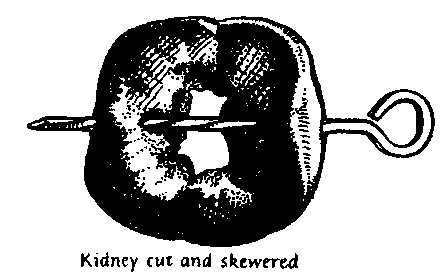
[g
p169]
340 Grilled Bacon Cooking time 3 5 minutes.
Gammon rasher 10-20 minutes, depending on thickness.
Remove the rind. With a gammon rasher cut the fat at intervals of
1 inch [25mm], to prevent the rasher from curling up during cooking.
Grill fairly slowly until the fat is clear.
341 Grilled Sausages. Cooking time 15-20
minutes.
Prick the sausages well to prevent bursting and grill fairly
slowly, turning frequently, until well browned. Serve with grilled
bacon, mashed or fried potatoes, any vegetable, and apple, onion, or
bread sauce.
FRYING
342 General Information.
As already mentioned in No. 306,
only the most tender cuts of meat are suitable for frying. For
suitable meat, see Nos. 306-11. You
will also find general instructions for frying in the chapter on fats
Nos. 156-7.
170 THE PENGUIN COOKERY BOOK
343 Fried Beef Steak.
1. Prepare the steak as described for grilling, No.
333, except that there is no need to brush with oil or fat, and
the meat can be cut in thinner slices.
2. Use a thick frying-pan and heat in it a very little lard,
dripping, or oil. When it is very hot put in the steak and brown for
1 minute on each side. Keep cooking over a fierce heat, turning every
minute or two. Cooking times are the same as for grilling.
3. Serve on a hot dish with any of the vegetables and garnishes
given for grilled steak. The frying-pan is generally swilled out with
a little liquid, such as wine, lemon-juice, or mushroom stock, and
the liquid poured over the meat.
344 Fried Lamb Cutlets.
These are cut from the best end of neck, and all surplus fat should be trimmed off, leaving about an inch of clean bone.
Beat the cutlets to flatten them a little, and then dip in egg and
breadcrumbs and fry in deep fat as described in No.
157.
Serve with any vegetables and a sauce, such as Onion, No.87;
Tomato, No.92; Brown, No.72;
Celery, No. 74; or Mushroom, No.
84.
345 Fried Chop. (veal, lamb, or pork).
These are fried in the same way as steak, but the cooking should
be very much slower, taking at least 20 minutes. After the meat has
been browned on both sides reduce the heat and finish the cooking
more slowly. It is often an improvement to cover the pan with a lid
and let the steam help to cook the meat. When the meat is cooked,
gravy may be made in the pan by the Roux Method, as described for
roast meat in No. 80.
With Pork Chops serve: Mashed or fried potatoes.
MEAT, POULTRY, AND GAME 171
Onions, carrots, celery, tomatoes, or turnips. Fried apple rings,
or tart jelly.
With Lamb Chops serve: Mashed or fried potatoes. Spinach, peas,
beans, tomatoes, or mushrooms.
With Veal Chops serve: Mashed or fried potatoes, macaroni, or
spaghetti. Tomatoes, carrots, celery, or beans. Tomato Sauce, No.
92; Apple Sauce, No. 107; Celery
Sauce, No.74; or Lemon.
346 Fried Liver, Kidneys, Bacon, and Sausages.
The same rules apply as for grilling, see No.
338. Gravy may be made in the pan in the same way as for roast
meat, see No. 80.
347 Escalopes of Veal.
These are very thin slices of meat cut from the fillet and are
delicious fried, either plain or coated in egg and breadcrumbs. The
veal should be pounded well to flatten it before cooking, and is then
fried in butter, fat, or oil until brown on both sides.
Serve with any of the vegetables and accompaniments given for Veal
Chops, No. 345.
348 Escalopes of Veal with Lemon.
Fry the veal in butter, without coating. Remove from the pan and
keep hot. Add a very little hot water to the pan and boil hard for a
minute or two. Then for every four escalopes, add the juice of 1
lemon and pour over the meat.
349 Wiener Schnitzel.
Coat veal escalopes in egg and breadcrumbs and fry in butter or
hot fat. Serve with slices of lemon and anchovy on each escalope.
Other garnishes sometimes used are olives, capers, hard-boiled eggs,
mushrooms, tomatoes.
172 THE PENGUIN COOKERY BOOK
ROASTING
350 General Information.
Ordinary roasting is only suitable for a limited number of cuts of meat which you will find given in Nos.
306-11.
An uncovered pan should always be used for true roasting, as, if the pan is covered, the meat is then cooked partly in steam, and is more like a pot roast or braise, see Nos.
359-61.
Basting is not necessary with any except very lean joints, such as veal. Poultry or game needs to be covered with fat bacon or basted well.
ROASTING METHOD 1
1. Place the meat in the roasting-pan and, if lean, add some extra fat or dripping.
2. Put the tin in a very hot oven ([250°C], 475°F. or Mark 9). Leave for 15 minutes or until the meat is brown. Reduce the heat to slow or moderate ([175°C], 350°F or Mark 4).
4. When cooked (for times see No.
351), lift out the meat and make the gravy in the pan by the Roux Method, as described in No. 80.
NB. If Yorkshire pudding is being cooked with the meat, reverse
the process, finishing with the hot oven to cook the pudding and
brown the potatoes.
ROASTING METHOD 2
The meat is prepared as before, but instead of going into a hot
oven, it starts slowly – [170-180°C] 325-350°F. or Mark 3- and
continues like that all the time. This method naturally takes longer. You will find the times given in No. 351.
Potatoes will not brown at this temperature. They should be
parboiled, and then the heat increased for the last half-hour to
brown them. It is advisable to cook them in a little fat in a
separate tin at the top of the oven.
MEAT, POULTRY, AND GAME
351 Roasting Time Table.
These times are for well-done meat, and can be varied to suit
individual tastes. Beef may be underdone, but lamb, veal, and pork
should always be well done, or they are indigestible. A thick rolled or stuffed joint will always take longer than a thin joint such as loin.
The times are correct for joints between 3 and 8 lb [1350-3600g].
With joints weighing less than 3 lb. [1350g] you should allow at
least 1½ hours for Method 1 and at least 2 hours for Method 2.
Very small joints are not really satisfactory roasted, and I would advise instead Braising, No. 361, or Pot Roasting, No. 360.
|
Meat
|
Method 1
|
Method 2
|
|
Beef or Mutton . .
|
[55-65 mins. per kg], 25-30 mins. per lb.
|
[90-100 mins. per kg], 40-45 mins. per lb.
|
|
Lamb . . .
|
[65 mins. per kg], 30 mins. per lb.
|
[100 mins. per kg], 45 mins. per lb.
|
|
Pork . .
|
[65-75 mins. per kg], 30-35 mins. per lb.
|
[90-100 mins. per kg], 40-45 mins. per lb.
|
|
Veal and Venison .
|
[65-90 mins. per kg], 30-40 mins. per lb.
|
[90-110 mins. per kg], 40-50 mins. per lb.
|
|
Chicken, Rabbit, Duck,Blackcock, Guinea fowl . . .
|
50-60 mins.
|
2 hrs.
|
|
Grouse, Pheasant .
|
40-50 mins.
|
1½ hrs.
|
|
Ducklings (not stuffed), Teal, Partridge, Ptarmigan, Wild Duck
|
35 mins.
|
|
|
Quails, Snipe, Ortolans, Plovers, Widgeon, Woodcock .
|
20 mins.
|
|
|
Goose ([2.7kg], 6 lb.), Young Hare . . .
|
1½-2 hrs.
|
2 hrs
|
|
Turkey:
|
|
|
Drawn weight [3.2-4½kg], 7-10 lb.
|
2 hrs.
|
3 hrs.
|
|
Drawn weight [4½-5½kg], 10-12 lb.
|
3 hrs.
|
4 hrs.
|
|
Drawn weight [6.8-9.1kg], 15-20 lb. . .
|
3½ hrs.
|
4½ hrs.
|
352 What to Serve with Roast Meat, Poultry,
Game.
BEEF. Roast or boiled potatoes. Any green vegetables. Baked
parsnips, marrow, pumpkin. Brown Gravy, No.
174 THE PENGUIN COOKERY BOOK
80 Horse-radish Sauce, No.
82; Yorkshire Pudding, No. 758.
LAMB OR MUTTON. Roast or boiled potatoes. Any vegetable. Mashed
turnips or swedes. Savoury stuffing. Currant jelly. Brown Gravy, No.
80; Onion Sauce, No. 87.
PORK. Boiled, roast, or mashed potatoes. Any green vegetable.
Celery, onions, tomatoes. Brown gravy. Sage and Onion Stuffing, No.
140. Baked or fried apples or Apple Sauce, No. 107;
Cranberry Sauce, No. 108. Tart
jelly.
VEAL. Boiled, roast, or mashed potatoes. Spinach, tomatoes,
onions, or beetroot. Veal Forcemeat, No.
142; Brown Gravy, No. 80. Boiled
or grilled bacon or salt pork.
CHICKEN. Mashed, fried, or roast potatoes. Cauliflower, celery,
peas, beans, onions, watercress, green salad. Stuffing, No. 142.
Currant jelly. Bread Sauce, No. 118;
Brown Gravy, No. 80. Bacon rolls.
DUCKLING OR DUCK. Boiled or roast potatoes. Peas, carrots,
turnips, orange salad. Apple Sauce, No.
107; Sage and Onion Stuffing, No.
140; or Veal Stuffing, No.142.
Tart jelly.
GOOSE. Roast or boiled potatoes. Any green vegetable. Onions or
carrots. Sage and Onion Stuffing, No.
140; or Apple and Prune Stuffing, No.
139. Apple Sauce, No. 107; Brown
Gravy, No. 80; Currant jelly.
Cranberry Sauce, No. 108.
RABBIT OR HARE. Roast or boiled potatoes. Any green vegetable.
Onions, carrots. Red-currant jelly. Brown Gravy, No.
80. Savoury stuffing.
TURKEY. Boiled, fried, or roast potatoes. Onions, peas, pumpkin,
sprouts. Sausages. Grilled bacon rolls. Cranberry Sauce, No.
108; Brown Gravy, No. 80.
Stuffing, No.141; Bread Sauce, No.
119; Celery Sauce, No. 74.
MEAT, POULTRY, AND GAME 175
GAME. Any of the accompaniments already given for poultry. Game is
not usually stuffed for roasting.
VENISON. Any potatoes and vegetables. Brown Gravy, No.
80. Red-currant jelly.
353 Reheating Roast Meat.
Slice the cold meat very thinly, and place the pieces overlapping
on a hot dish. Pour over well-seasoned boiling gravy or sauce. There
will be sufficient heat in the sauce to warm the meat. The flavour is
spoiled if meat is re-cooked.
354 Roast Stuffed Veal.
The most suitable cuts to use are the loin or shoulder, which
should be boned. Veal Forcemeat, No. 142,
gives the best flavour. The stuffed loin should be skewered or tied
into a roll.
Another method of stuffing loin is to separate the meat from the
bone just enough to make a pocket for the stuffing. Fasten up the
opening.
355 Roast Stuffed Pork.
The most suitable cuts to use are loin or leg. Sage and Onion
Stuffing, No.140, is the usual one,
but Celery Stuffing, No. 135, is also
very good. The leg should be boned for stuffing, but the loin can be
boned or not as described for Veal, No.
354. To make crisp Crackling, rub salt into the skin before
roasting.
356 Roast Stuffed Lamb.
The most suitable cuts are loin, leg, or shoulder. The following
stuffings are the best: Veal Forcemeat, No.142,
or Mint or Watercress, No. 138. The
joint is usually boned for stuffing, but the loin may be treated as
for Veal, No. 354.
176 THE PENGUIN COOKERY BOOK
357 Savoury Roast Pork.
Score the skin of a 4-lb. [1800g] roast in lines ¼ inch apart.
Mix the following seasonings together, and rub them well into the
pork before roasting in the usual way:
Measures level.
½ tsp. powdered sage
½ tsp. pepper
½ tsp. dry mustard
1 finely chopped onion
½ tsp. salt
358 Roasting a Boiling Fowl.
Stuff in the usual way, and then roast in a very hot oven, 500 F. [260°C] or Mark 10, until brown. Then steam for 1-2 hours or pressure
cook for 15-20 minutes, or until tender. Keep the roasting-pan and
fat to make the gravy by the Roux Method as in No.
80.
POT ROASTING AND BRAISING
359 General Information.
These are both useful methods for treating a joint which is not
sufficiently tender for ordinary roasting. For suitable cuts, see
Nos. 306-11. They are also very
useful ways of cooking the not-so-young game and poultry, or for
steaks and chops, especially those which require thorough cooking,
such as veal or pork chops.
Although both pot roasting and braising were originally carried
out in saucepans on top of the stove, they may equally well be done
in a slow oven. In both cases the meat is browned in a little fat,
and then cooked slowly with the lid on. If you want to cook it in the
oven and have no casserole which will stand frying heat, brown the
meat in a frying-pan, and then transfer it to the casserole. If
cooking is done on the top of the stove, a heavy pan must be used,
otherwise the meat will stick and burn.
MEAT, POULTRY, AND GAME 177
Using a covered roasting pan and roasting by Method 1, No.
350, gives very similar results to pot roasting.
360 Pot Roasting. Temperature 325-350 F. [163-177°C] Mark 3.
1. Melt enough fat to cover the bottom of the pan.
Then fry the meat over a good heat until it is well browned.
2. Put on the lid, which should be a good fit, and reduce the
heat. Cook slowly until tender, turning the joint over occasionally.
Allow the same times as for Roasting, Method 2, No.
350, with a minimum time of 2 hours for joints weighing less than
3 lb [1350g]. Potatoes and vegetables may be cooked round the meat
but will not brown.
3. Lift out the meat and pour off surplus fat, making the gravy by
the Roux Method, as described in No. 80.
Serve with any of the accompaniments given for Roast Meat, No.
352.
361 Braising. Temperature 325-350 F. [163-177°C] Mark 3.
1. Begin by trimming off all surplus fat. You can render this down as described in No. 145. The reason for cutting off the fat is to avoid having the finished dish too greasy which would make it unappetising and indigestible.
2. Peel, and dice or slice enough vegetables to make a layer about 2 inches thick, on the bottom of the pan. If you want the dish to have a special flavour, use just one vegetable alone, for example, onions or tomatoes; or use a mixture of vegetables such as onions, carrots, celery, turnips, tomatoes, parsnips, peas, and swedes.
3. Heat enough fat to cover the bottom of the saucepan. Put in the meat and cook over a good heat until it is brown all over.
4. Lift out the meat and fry the vegetables until they are
slightly browned. Then pour off any fat.
178 THE PENGUIN COOKERY BOOK
5. Put the meat on the bed of vegetables and add just enough stock to moisten, or to come almost level with the top of the layer of vegetables. Add salt and pepper and herbs such as bay leaf, sprig of parsley, and thyme, or their equivalent in dried herbs.
6. Put on a lid which fits tightly, and cook very gently until the
meat is tender. The times are the same as for Roasting, Method 2, No.
350, with a minimum time of 2 hours for a joint weighing less
than 3 lb. [1350g], ¾-1 hour for chops, 1½-2 hours for pieces of
steak.
7. Braised meat looks best if cut in slices and arranged on a dish
with the vegetables round it. Put in a warm place while the gravy is
prepared. First skim off as much fat as possible. The liquid may then
be used as it is or thickened with flour by the Blending Method, see
No. 93. Colour with gravy browning
according to taste. The same vegetables and accompaniments as for
Roast Meat, No. 352, are suitable for
braised meat, game, or poultry.
362 Spanish Cutlets. Cooking time ½-¾ hour.
Temperature 350 F. [163°C] Mark 4.
Quantities for 4 helpings:
1 oz. [15g] dripping (2 Tbs.)
1 onion, sliced
4 lamb cutlets
1 lb. [450g] tomatoes, sliced
Salt and pepper
8 small sausages
1 rasher bacon, chopped
Trim the cutlets, removing as much fat as possible. Fry brown in
the dripping. Place in a casserole and season with salt and pepper.
Fry the onion and bacon in the same fat and, when the onion begins to
brown, add the tomatoes. Cook for 10 minutes. Add to the cutlets and
cook in a moderate oven for ½ hour, with the lid on the casserole.
Bake the sausages separately and serve with the meat and tomatoes.
Serve with baked or mashed potatoes.
MEAT, POULTRY, AND GAME 179
363 Spiced Steak. Cooking time 1½ hours.
Temperature 325 F. [163°C] Mark 3.
Quantities for 3-4 helpings:
1 lb. [450g] beef steak
1 onion, sliced
Salt and pepper
¼ bay leaf
1 oz. [15g] dripping (2 Tbs.)
½ tsp. grated nutmeg
Measures level. Beat the steak well to flatten it, and then season
with salt and pepper. Fry in the dripping until well browned on both
sides. Add the onion, bay leaf, and nutmeg. Cover with a fitting lid
and cook slowly for 1½ hours. If necessary, add a very little water
during cooking.
Cooking may be in the oven or on top. Serve with mashed potatoes
and any green vegetable.
364 Braised Chicken. Cooking time 1½ hours.
Temperature 350 F. [163°C] Mark 4.
Quantities for 4-6 helpings:
1 chicken
1 tsp. salt
2 oz. [55g] butter (4 Tbs.)
¼ tsp. pepper
Measures level. Clean and truss the chicken, see No.
313. Melt the butter in a casserole. When hot add the chicken,
and fry until brown all over. Sprinkle with the salt and pepper.
Cover and cook gently until tender. Cook the chicken lying on its
side and turn two or three times during cooking. Pour the juice and
butter over the chicken before serving. The best way of serving is to
carve the chicken and arrange it on a large platter before pouring
over the juice. Serve with green peas and new potatoes.
MINCED MEAT
365 General Information.
Mincing is a very useful way of making tough meat tender without
long, slow cooking. The mincer breaks up
180 THE PENGUIN COOKERY BOOK
tough connective tissue, making the meat easy to chew. An
interesting fact about mincing is that the smaller the meat is minced
the less natural flavour it has. On the other hand, fine mincing
makes a smoother and more tender mixture, and herbs and seasoning can
be added for flavour. Even with the cheapest cuts of meat, twice
through the meat mincer is about right. If the meat has thick streaks
of gristle in it, these should be cut out before mincing.
One kind of meat can be used alone, or a mixture of two or more
kinds. Fat bacon goes very well with beef and veal, and a mixture of
beef, pork, and veal is very good. Liver, heart, sausage, etc., may
also be mixed with the meat to make up the weight.
366 Minced Meat. Cooking time 15 minutes or
longer depending on how used.
Quantities for 4-6 helpings:
1 lb. [450g] lean raw meat (see No.
365)
1 tsp. ground mace
4 Tbs. milk or water
1 c. fresh breadcrumbs or 4 Tbs. dried crumbs
Chopped or dried herbs (marjoram, basil, savory, thyme, etc.) to
taste
1 tsp. salt
¼ tsp. pepper
2 Tbs. onion, chopped and fried
Measures level.
1. Put the meat once or twice through the mincer, or until it is
fine enough to hold together smoothly.
2. Add the bread and flavourings. There is no need to fry the
onion first if the meat is to be cooked in a loaf or mould for some
time, although frying does improve the flavour. It is essential to
fry the onion for meat cakes and meat balls, as otherwise it will not
cook in time and there will be raw onion in the middle of the meat
cake. Flavourings can be added according to taste, and any fresh
MEAT, POULTRY, AND GAME 181
or dried herbs are suitable, also spices, which can be blended to
give individual flavours, or a minute speck of garlic.
3. Mix well, using a wooden spoon, and working until the mixture
is smooth, adding liquid as needed. The mixture should be moist
without being difficult to handle.
4. Shape on a board with floured hands, and use in any of the ways
suggested in Nos. 367-70.
367 Grilled or Fried Meat Rissoles. Cooking
time 10-15 minutes.
Divide mixture No. 366 into eight
equal portions, and pat and shape each into a flat rissole ½-1 inch [15-25mm]
thick. Do not make them too thick, or the outsides will be hard
before the insides are cooked.
GRILLED. Cook under a fierce heat until brown and then more slowly
to finish.
FRIED. Brown in a little hot fat and finish the cooking more
slowly. Keep hot while making gravy in the pan according to No.
80.
Serve either fried or grilled rissoles with fried or mashed
potatoes, and any vegetable. Brown gravy or tomato sauce. Fried
onions.
368 Baked Meat Rissoles. Cooking time 20-30 minutes. Temperature
450 F. Mark 8.
Use Recipe No. 366. The nicest way
of baking is to wrap a thin rasher of streaky bacon round each
rissole, fastening it with a tooth-pick or small skewer. Place on
slices cut from a large onion and pre-cooked in a little fat for 5
minutes. Serve with fried potatoes and spinach, peas, beans, or
tomatoes. Gravy may be made in the pan in the same way as for Roast
Meat, see No. 80.
182 THE PENGUIN COOKERY BOOK
369 Casserole of Pork Rissoles
Temperature 375 F. [191°C] Mark 5.
Use pork for the meat in No. 366,
and flavour with a pinch each of ground nutmeg, ginger, cloves, and
mace. Fry brown and put in a casserole. Fry in the same fat:
1 sliced onion
2 stalks celery, chopped
2 tomatoes, chopped
Add 2 Tbs. flour and mix well and then stir in ½ pt. [270ml] stock, 1
tsp. salt, ¼ tsp. pepper, and 2 Tbs. wine vinegar.
Pour over the meat, cover, and cook in a slow oven for ¾ hour.
Serve with boiled or baked potatoes and cabbage or other green
vegetables.
370 Meat Rissoles Jardiniere. Cooking time
10-15 minutes.
Fry the meat rissoles as in No. 367
and serve surrounded with heaps of two or three different vegetables,
such as diced carrots, peas, diced turnip, beans, etc.
371 Swedish Meat Balls. Cooking time 10-15
minutes.
Quantities for 20-30 balls:
1 lb. [450g] lean raw beef or beef and pork mixed
¼ tsp. pepper
2 Tbs. onion, chopped and fried
1 large boiled potato, mashed
¼ tsp. ground mace
1 tsp. salt
4-8 Tbs. milk or water
Measures level. Mince the meat three times to make it very smooth.
Add the other ingredients and shape into small balls. Fry in a little
hot fat, taking care not to crowd them in the pan, and turning until
brown all over. Put in a dish to keep hot. Pour 2-3 Tbs. water in the
pan and swill it round. Pour over the meat balls. Serve with boiled
or browned potatoes and any vegetable.
MEAT, POULTRY, AND GAME 183
372 Meat Balls in Tomato Sauce. Cooking time
10-15 minutes.
Make according to No. 371 and,
when cooked, put in ¾ pt. [425ml] Tomato Sauce, No.
92, and heat for a few minutes. Serve with mashed or boiled
potatoes and spinach, peas, beans, or any green vegetable.
373 Grilled Meat Bails with Cheese. Cooking
time 10-15 minutes.
Make meat balls from Recipe No. 371,
leaving out the onion, but adding 2 oz. [50g] grated cheese. Thread these
on skewers alternately with mushrooms and small tomatoes and grill
for 10-15 minutes. Serve with fried potatoes or Risotto, No.
551.
374 Meat Loaf. Cooking time ¾ hour.
Temperature 375 F. [191°C] Mark 5.
Make according to No. 366, adding
a tiny speck of garlic for extra flavour. Shape into a loaf and bake
in a moderate oven with a little fat round and a piece of greased
paper on top. Remove the paper for the last 10 minutes to allow the
top to brown. Make gravy in the pan in the same way as for Roast
Meat, No. 80, or serve the loaf with
Tomato Sauce, No.92. For serving, cut
in slices about ¾ inch thick. Any vegetables are suitable.
375 Meat Shape to Serve Cold. Cooking time 2
hours.
Make according to Recipe No.366,
and put the mixture in a greased basin, or stone jar, or tin with
straight sides.
Cover with greased paper and steam for 2 hours. Turn out and roll
in dried breadcrumbs, and cut in thin slices when cold. This cold
shape is nicest if a little bacon can be used with the meat. Pork
mixture No. 369 also makes a very
good loaf, and so does a mixture of liver, sausage, and bacon.
184 THE PENGUIN COOKERY BOOK
USING COOKED AND CANNED MEAT
376 General Information.
Meat which has already been cooked needs very careful handling. If
re-cooked, it is apt to be tasteless and needs additional flavouring,
best provided by a well-seasoned sauce. I have already suggested, in
No. 353, how to reheat roast meat.
Cold roast, braised or boiled meat, and canned meat, such as corned
beef or other whole meat, may be served with salad or hot vegetables,
such as Browned Potatoes, No.456, or
fried or roast potatoes, and a vegetable mixed with a well-flavoured
sauce.
This is an opportunity to use some of the more elaborate vegetable
dishes. Chutney, pickles, sweet pickled pears, pickled walnuts, or
gherkins all add zest to this sort of meal.
377 Cold Meat Hash. Cooking time 10-15
minutes.
Quantities for 4 helpings:
1½ C. Brown Sauce, #
72; or Curry Sauce, No.
77; or Tomato Sauce, No. 92
2 C. minced cooked meat
Measures level. Make the sauce and heat the meat in it without
boiling. Make sure it is well seasoned. A little Worcester Sauce or
Mushroom Ketchup improves the flavour. Serve with boiled potatoes and
any vegetable.
378 Shepherd's Pie. Cooking time 20 minutes.
Temperature 450 F. [232°C] Mark 8.
Quantities for 4 helpings: Meat and sauce as for 1½ lb. mashed
potatoes. No. 377
Put the meat and sauce in a pie-dish and cover with the mashed
potatoes. Decorate the top by roughing with a
MEAT, POULTRY, AND GAME 185
fork or piping potato through a forcing-tube. Bake in a hot oven
until brown on top. This is always nicer if the potatoes are freshly
cooked.
If the sauce and meat are heated before putting the mixture in the
dish it can then be finished off under the grill instead of going
into the oven.
379 Corned Beef Hash. Cooking time 10 minutes.
Quantities for 2-3 helpings:
1 c. diced corned beef
Fat for frying
2 c. diced cooked potatoes
1 small onion, sliced
1 Tbs. milk
Measures level. Mix the meat and potatoes. Fry the onion brown in
the fat. Add the meat mixture and sprinkle over the milk. Stir well,
and then leave on a very low heat until brown underneath. Fold over.
Turn out and serve hot. Follow with a salad.
380 Red Flannel Hash.
Add ½ c. dried cooked beetroot to mixture No.
379.
381 Fricassee of Cooked Veal or Poultry.
Cooking time 10-15 minutes.
Quantities for 3-4 helpings:
¾ lb. [375g] cooked meat
2 egg-yolks
½ Pt. [285ml] Medium Sauce,
#69, made with meat stock or milk
(1 c.)
Juice of 4 lemon
1 Tbs. chopped parsley
3 or 4 rolls fried or grilled bacon
Salt and pepper to taste
Pinch of nutmeg
Measures level. Heat the meat in the sauce and season well. Just
before serving stir in the eggs and cook for a minute or two longer.
Add the lemon and parsley and garnish with the bacon rolls. Serve
with mashed potatoes and spinach, peas, or carrots.
/p185
previous
contents index
next











